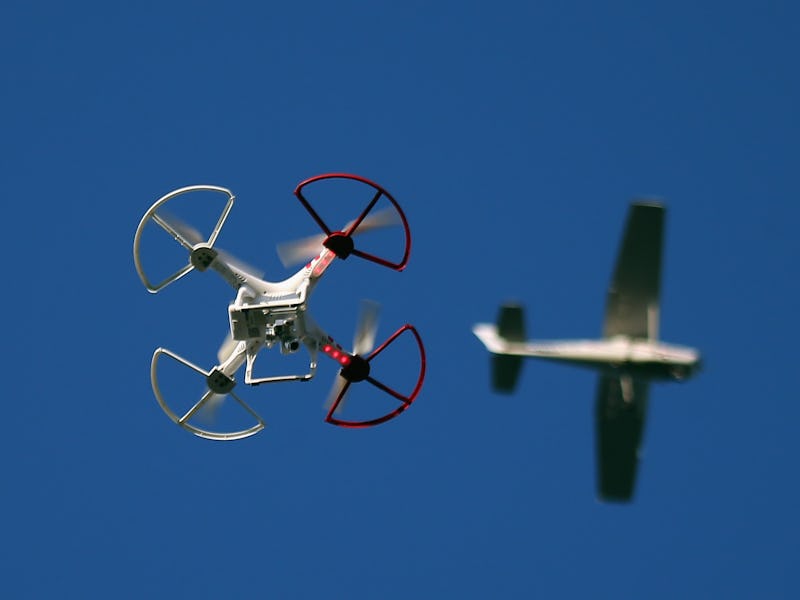Calculations Show That Catastrophic Drone-Aircraft Collisions Will Happen
UAVs don't grind down like geese.

No one can say with absolute confidence what will happen when civilian drones — camera-equipped quadcopters that weigh half a dozen pounds — collide with aircraft because it hasn’t happened yet. But the prognosis is grim. The Federal Aviation Administration, taking the spooked cat approach, reported in August that there were 650 “close calls” (though hobbyist groups, like the Academy of Model Aeronautics, dispute how close those calls were). What everyone can agree is that civilian or “toy” drones do pose potential risks, with regulatory bodies and interest groups alike hammering home the importance of good flying habits.
Quantifying that safety risk is a whole other story.
“We need to recognize the dangers that toy drone pose to manned airspace,” W. Hulsey Smith, CEO of aerospace and defense tech company Aero Kinetics, tells Inverse. Smith and Freddie L. Main III, an Aero Kinetics mechanical engineer, believe that collisions should be treated as an inevitability. “Statistically, I would say it’s a certainty,” Smith says, citing the explosive growth of the civilian drone industry (estimates of 200,000 drones a month and the FAA’s prediction of a million drones for the 2015 holiday season).
On Thursday, Smith and Main released a report comparing the destructive potential of drone strikes to the destructive reality of bird strikes (we all remember Captain Sully). Birds, as the Indiana Jones fan will recall, can cause surprising amounts of damage to aircraft; the authors cite $951,000,000 in damage annually from birds colliding with planes and helicopters.
At first blush, a 6-pound DJI Inspire and a 7-pound Canada goose might seem like they have similar destructive potential, by sheer virtue of mass. It’s a tempting equivalency, but also wrong.
“Birds are mostly made up of water — they’re squishy,” Main says, “and have a high modulus of elasticity.” Drones, on the other hand, are metal and chrome and carbon fiber, and apt to fracture into shrapnel rather than squish. Main likens the difference to crashing an Indy 500 race car into a concrete wall or a foam barrier.
Based on impulse calculations from the new study, damage and injury from direct collision with a rotocraft windshield “qualitatively show to be nonsurvivable based upon the kinetic energy of the impact.” That’s bad news for both drone pilots and airline pilots. That said, it’s worth noting that there is no consensus yet on the findings. A drone-turbine modeling expert who declined to be named questioned whether the impulse equation used in the study could model damage adequately.
This is all theoretical, however, and one of only a handful of studies exploring drone-plane collisions; in October, engineers at Virginia Tech modeled what would happen in a turbine sucked in a drone. The models revealed, according to a press release:
“An 8-pound quadcopter drone can rip apart the fan blades of a 9-foot diameter turbofan engine during take-off in less than 1/200th of a second. The speed of drone debris thrashing about inside the engine could reach speeds 715 miles per hour. Broken blades also would create more fragments as the fan crumbles and warps the engine block housing, contributing to catastrophic engine failure.”
Smith and Main recognize that the research outlined in the report is fairly introductory — there are many more factors contributing to a crash than impulse alone — and call for more concrete studies like an air cannon that fires a drone into a test turbine. This is a procedure already used in the industry, blasting simulated hail and bird corpses into jet engines:
All of the models thus far have been single strikes — we don’t know what will happen once drone swarms become a reality. The most catastrophic airliner bird strikes, such as US Airways Flight 1549, have occurred when turbines have sucked down whole gaggles of geese. “It’s a good question. It’s possible you could have a swarm of drones or several drones in the same environment,” Smith says, “though that is probably less likely than a flock of birds.”
The industry authors emphasize they’re not anti-drone — the idea is that civilian drone fliers, particularly those new to the hobby, take care when launching their machines into the skies. “Just as well all should drink responsibly,” says Main, “we should fly responsibly.”
Animation courtesy of Crashworthiness for Aerospace Structures and Hybrids (CRASH) Lab, Virginia Tech, May 2015.